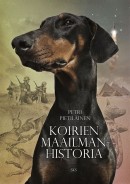Petri Pietiläinen: Koirien maailmanhistoria [A world history of dogs]
24 April 2014 | Mini reviews, Reviews
 Koirien maailmanhistoria
Koirien maailmanhistoria
[A world history of dogs]
Helsinki: Finnish Literature Society, 2013. 344 pp .
ISBN 978-952-222-351-7
€34, hardback
By partly fictional means this book tells the compelling story of the dog, particularly from a cultural and historical perspective. Recent archaeological finds suggest that man has tamed dogs for more than 30,000 years. Descended from wolves, during the Stone Age they became common as domestic animals. In Finland, too, there have been finds that indicate that this was so. The dog was used for hunting and as a sentinel, and later in a variety of service tasks. From early on they were mythical creatures, worshipped in some cultures, in others shunned, and in some bred to be eaten. While in 17th-century Europe dogs were sentenced to death at trials, in Japan it was nobles who faced the death penalty for ill-treating their dogs. The book also presents the fascinating stories of dogs both famous and nameless, beginning with Alexander the Great’s dog Peritas. In the Western world the dog was not treated as a member of the family until the modern era, though in prehistoric burial sites there are indications of its having been a close companion of man. Pietiläinen links the story of the dog to more general history in an insightful way.
Translated by David McDuff
Tags: animals, cultural history, history
No comments for this entry yet
